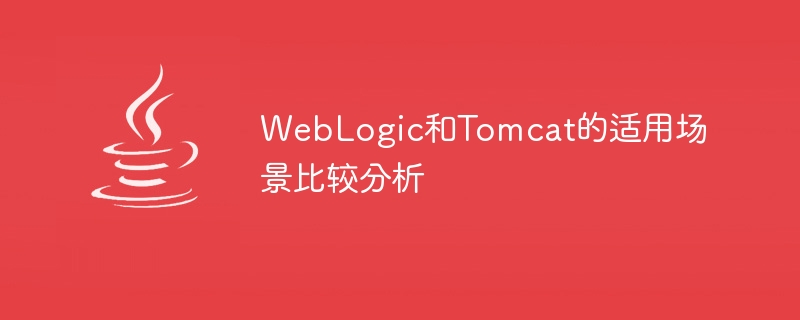Home >Java >javaTutorial >Comparative analysis of the applicability of WebLogic and Tomcat in different application scenarios
Comparative analysis of the applicability of WebLogic and Tomcat in different application scenarios
- 王林Original
- 2023-12-28 08:45:201116browse

WebLogic and Tomcat are two commonly used Java application servers, both of which can provide the running environment and support for Java applications. However, they have some differences in functionality and applicable scenarios. This article will conduct a comparative analysis between WebLogic and Tomcat so that developers can choose the most appropriate application server according to their own needs.
First of all, WebLogic is a powerful enterprise-level application server that provides many advanced features, such as clustering, load balancing, high availability, and fault recovery. It can support large-scale enterprise applications and has good scalability and reliability. In addition, WebLogic also provides a wealth of management tools and monitoring functions to facilitate administrators to manage and monitor application servers.
In contrast, Tomcat is a lightweight Java Servlet container that focuses on providing basic Servlet and JSP support. Tomcat is more suitable for developing and deploying smaller-scale Web applications, such as personal websites, simple enterprise applications, and small and medium-sized e-commerce websites. It has simple configuration and easy-to-use interface, making it friendly to beginners.
Another important difference is that Tomcat is a free open source project and can be downloaded and used for free. WebLogic is a commercial product provided by Oracle and requires the purchase of a license. For small projects and individual developers, Tomcat is a more economical choice.
In terms of performance, Tomcat is relatively lightweight and therefore gets up and running faster. For many simple web applications, Tomcat's performance is often sufficient. WebLogic is suitable for enterprise-level applications with high performance requirements and the need to handle a large number of concurrent user requests. It has more powerful processing capabilities and resource management mechanisms to ensure that applications can run stably and efficiently.
In general, choosing WebLogic or Tomcat depends on the size and requirements of the project. If you are developing a small web application or personal website and do not have very high performance requirements, then Tomcat may be a more suitable choice. It has an easy-to-use interface and is free and open source. And if you want to develop a large-scale enterprise-level application, or need to use advanced features such as clustering, load balancing, etc., then WebLogic is a more suitable choice. It provides more powerful features and management tools to meet the needs of enterprise-level applications.
Whether you choose WebLogic or Tomcat, developers should evaluate and choose an application server that suits them based on actual needs and the size of the project. During the development process, you can make full use of their features and functions to improve development efficiency and application performance. At the same time, keep an eye on their updates and improvements in order to adopt new features and fix known issues in a timely manner.
The above is the detailed content of Comparative analysis of the applicability of WebLogic and Tomcat in different application scenarios. For more information, please follow other related articles on the PHP Chinese website!
Related articles
See more- Summary of problems encountered by thinkphp5 during server deployment
- What does performance core display mean?
- Teach you step by step Linux PHP environment deployment and project launch (share)
- What is the difference between integrated graphics and high performance nvidia processors
- What is the performance difference between 3050ti and 4060?

